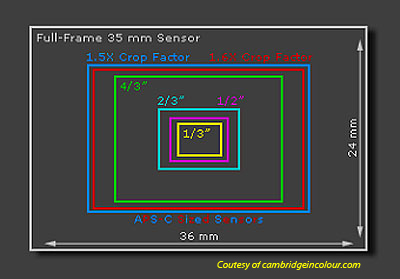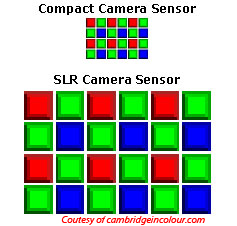The Digital Sensor: A Guide to Understanding Digital Cameras
by Wesley Fink on April 21, 2008 1:00 AM EST- Posted in
- Digital Camera
Sensors Today
| Sensor Size (mm) | ||
| Type | Width | Height |
| 1/3.6" | 4.00 | 3.00 |
| 1/3.2" | 4.54 | 3.42 |
| 1/3" | 4.80 | 3.60 |
| 1/2.7" | 5.37 | 4.03 |
| 1/2.5" | 5.76 | 4.29 |
| 1/2" | 6.40 | 4.80 |
| 1/1.8" | 7.18 | 5.32 |
| 1/1.7" | 7.60 | 5.70 |
| 2/3" | 8.80 | 6.60 |
| 1" | 12.80 | 9.60 |
| 4/3" | 18.00 | 13.50 |
| APS C | 23.70 | 15.70 |
| 35mm film | 36.00 | 24.00 |
In the above chart, the sensor sizes for today's DSLR cameras are in the range of 4/3" and APS C. A few top pro cameras now sport 35mm-size sensors and are referred to as full frame. Comparing this to Compact or Point and Shoot cameras today we generally find a 1/2.3" to 1/2.5" sensor. A few top-of-the-line compact cameras, like the Canon G9, feature a 1/1.8" to 1/1.7" sensor. To see the difference in the relative size of P&S sensors and DSLR sensors, look at the graphic below.

The very best compact cameras have sensors around the 1/3" to 1/2" range. The APS C to 4/3 sensors of the bulk of today's digital SLR cameras are huge by comparison. The developing push for full-frame at the top of the current DSLR market is a move to a sensor that is a bit more than double the size of today's APS C sensors. The approximate 24mm by 16mm APS C is the same size as the 1/2 frame 35mm championed by Olympus in the film era.
This size actually harkens back to 35mm motion picture film that became the standard on which most of the SLR lens systems are based. 35mm motion picture film contained images of around 24x16mm, and 35mm still film just turned the spool direction and used double the frame size. In fact, some early 35mm still cameras were referred to as "double-frame" cameras.
Why Does Sensor Size Matter?
In some of life's arenas bigger is better, but in computers and electronics we almost always see a trend toward smaller and smaller traces producing chips with higher and higher densities. So the question becomes why is a 10MP DSLR sensor any better than a 10MP Compact or Point and Shoot sensor?
The simple answer is that computer chips are digital devices, made up of transistors that register on and off (1 and 0) states, which are then combined to create the information we crunch in a computer. Digital sensors, on the other hand, are analog devices used to gather light and color information. Every digital camera then has some means to convert this analog sensor data to digital information in its processing path. Devices that communicate on and off do not require the sensitivity of devices that gather and convey more complex data like a digital sensor pixel.

Unlike digital data, all pixels are not created equal. Larger sensors, such as those used in digital SLR cameras, have larger pixels. All things being equal the larger pixels have more light-gathering ability over a given unit of time. This translates into two very important considerations for photography.
First, larger pixels exhibit lower noise than smaller pixels under the same conditions. This improved signal-to-noise ratio means that your 10MP DSLR image will likely produce better, sharper, clearer prints than the smaller 10MP compact (point and shoot) cameras. This improved SNR also means larger sensors produce a wider dynamic range (a greater range between the lightest and darkest elements of the photo).
The second aspect also relates to light gathering ability. Large DSLR sensors have more ability to gather light, which means they generally are more effective over a much wider range of lighting conditions than a compact camera. Many compact cameras are perfectly acceptable at ISO 100 but are very noisy by ISO 400. Most DSLR cameras with their larger sensors produce very acceptable results to ISO 800 or 1600 - ISO options not even available on most compact cameras. Some newer DSLR cameras even offer options of ISO 3200, ISO 6400, or even higher.










72 Comments
View All Comments
Johnmcl7 - Monday, April 21, 2008 - link
On page 4:"The Foveon sensor falls between 4/4 and the Canon 1.6 in size and has a 1.7X lens multiplier."
I assume this should read '4/3'
Obvious question is what about Fuji? While I realise they re-use Nikon bodies and lenses, the discussion about Bater and Foveon makes no mention of Fuji's sensor. While it is more conventional than the Foveon, it's not just a bog standard bayer sensor and while Fuji are a minor player, so are Sigma.
For those who are not familiar with Fuji's design, they use two photodiodes at every point one larger and one smaller with the two combined to produce a single pixel in the output image. The idea is that these pair of pixels can capture more extended dynamic range than a standard bayer sensor of the same size. The latest version of this sensor is in the Fuji S5 Pro however it's limited to just 6MP although I can't remember if they still produce 12MP files from this. The S5 itself is basically a Fuji version of the very good Nikon D200 body although Nikon have of course moved on with the very impressive D300.
John
Wesley Fink - Monday, April 21, 2008 - link
Yes, it should have read 4/3 and the reference is corrected. The Fuji S3 was one of my favorite Nikon bodies and the dynamic range was certainly impressive in the studio.We did not mean to slight Fuji, but as one Nikon-mount body with a sensor that hasn't been updated in several years (the S3 and S5 sensors are the same as I understand it) we decided not to include the Fuji since there have been no sensor updates in quite a while.
Johnmcl7 - Monday, April 21, 2008 - link
"We did not mean to slight Fuji, but as one Nikon-mount body with a sensor that hasn't been updated in several years (the S3 and S5 sensors are the same as I understand it) we decided not to include the Fuji since there have been no sensor updates in quite a while. "I can't say I really agree there, given the article more focuses on concept in parts I think the S5 sensor is still relevent as it's something slightly different to the bayer sensor. The article refers to only Bayer and Foveon which implies there is nothing else, I think for completeness even if you don't go into any detail it's still worth mentioning Fuji are doing something else.
Also the S3 and S5 sensor are not the same, while they have the same amount of pixels it appears there's been some slight improvements although clearly not much. To be far to Fuji though, the Foveon sensor hasn't really come on much either - it's gone up very slightly in resolution with some small other changes but that's it pretty much. If the Foveon sensor had been just mentioned in passing I could definitely understand leaving Fuji with a similar mention but generally Fuji and Sigma are considered in the same boat as doing something a bit different although arguably with the Nikon body and mount Fuji have had more success.
John
melgross - Tuesday, April 22, 2008 - link
I never saw an advantage to their designs. I can't see what purpose having a smaller photo site on the sensor would do. It just has more noise, and less dynamic range than the larger sensor. I've read their papers on the subject, and they don't seem to have made a good case for it. Somehow, I think they understand that now.Johnmcl7 - Thursday, April 24, 2008 - link
"I never saw an advantage to their designs. I can't see what purpose having a smaller photo site on the sensor would do. It just has more noise, and less dynamic range than the larger sensor. I've read their papers on the subject, and they don't seem to have made a good case for it. Somehow, I think they understand that now."Are you referring to Fuji? If so, your information is incorrect - the last measurement I saw put the S5's sensor at slightly more dynamic range than the 35mm sensor in the Nikon D3. Their real problem at the moment seems to be resolution as well as having the older D200 based body.
John
strikeback03 - Tuesday, April 22, 2008 - link
I think Sigma (and Foveon) would be better off if Sigma could license a major player's mount, like Kodak did with the SLR/n and SLR/c. There are plenty of people who would like to have the sensor for the situations where it excels, but have no interest in a whole Sigma SA mount setup.pinto4402 - Monday, April 21, 2008 - link
I've been reading Anandtech for over 8 years now. I was a bit skeptical about your doing articles on digital cameras; however, this article put my reservations to rest. Very nicely done.I see why it makes sense for Anandtech to write about digital cameras. The nexus between computer tech and camera tech are very obvious if you've been following the trends. I'm a professional portrait photographer. In the last few years, it has become virtually impossible to remain in business unless you have a firm grasp on the latest camera tech as well as computer tech. I spend as much time on my computer as I do behind the camera. The camera has become a computer accessory (or vice versa). Many old timers who are hanging on to film are slowly being forced out. I'm somewhat of an old timer myself because I learned about photography when it was cool to have a darkroom, but I embraced digital equipment early.
Your graphs make it very easy to explain to people why their P&S (piece of s***) cameras are simply not adequate for serious portraiture. The MP count is marketing crap. As you demonstrated, it's the physical size of the sensor that matters.
Looking forward to part II of the series. Also, do you have any solid info on the introduction of 5D Mk II?
bjacobson - Tuesday, April 22, 2008 - link
"The MP count is marketing crap."Mostly. If you're willing to do some post processing yourself, the higher MP will enable you to decrease the IQ gap between the higher end DSLR and the ho-hum consumer camera. For this reason, since I wanted something compact and didn't really need a lot of optical zoom, I chose the Canon SD1100IS. 8MP, and while you begin to get noise at ISO400, more at ISO800, and tons at ISO1600, using a non-linear digital filter should correct most of that without blurring the image much (if at all).
strikeback03 - Wednesday, April 23, 2008 - link
Problem is that the camera has already blurred away lots of your detail at ISO 400 and up.http://www.dpreview.com/reviews/canonsd1100is/page...">http://www.dpreview.com/reviews/canonsd1100is/page...
Too bad there is no option to reduce/turn off the in-camera NR, for those of us who own a better program for it already.
Wesley Fink - Monday, April 21, 2008 - link
I wish I did have definitive info about the 5D Mark II launch, but the best info I have is this fall at Photokina. Rumors pop up every month that the new 5D will be here in a few weeks - and the last rumor was a definite April 22, which is tomorrow. Rumors are just that - rumors.